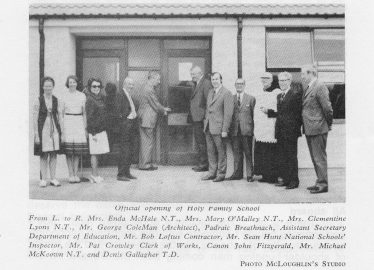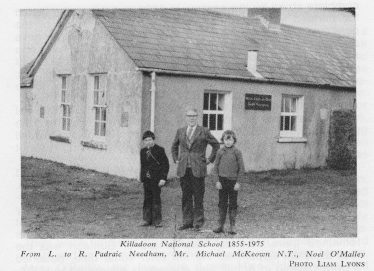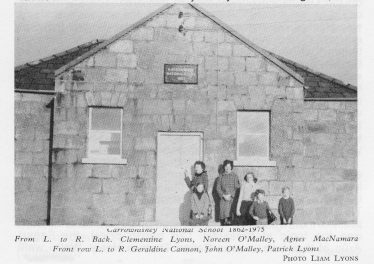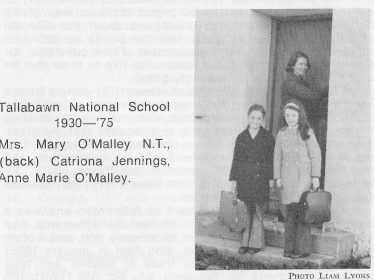
Official opening of Holy Family School
A new central school at Killeen – The Holy Family School – was opened by Mr. Pádraic Breathnach. It replaces Killadoon, Thallabawn and Carrowniskey National schools.
The Old Schools:
Killadoon
Prior to the establishment of the National School system in 1831 Gaelic culture was kept alive in the hedge-schools by the wandering teachers. A man named Paddy O’Grady settled in Aillemore, and as he was considered capable of instructing those who were interested, he set up a hedge-school in the village teaching in his barn during the warmer months and moving to more comfortable quarters of his kitchen during the cold winter. This school continued for some time up to about 1854. Shortly after this it was decided by the authorities to build a National School in Killadoon, and for this purpose a small portion of land was purchased from the Lyons family at a cost of five pounds. It was indeed, a very small site, being about thirty yards by fifteen, with the result that there was no playground. I imagine, though, that there must have been some trespassing taking place during play-hour! Immediately outside the west wall of the yard were the ruins of an old circular fort, a fort which helped to give the village its name, and a few feet outside the north wall was An Staca Mór, under which, I suppose, some chieftain who lived in the fort is buried. A few hundred yards to the north-east are traces of the church in which the people worshipped before Gowlaun was built. The school was small; just one room thirty-three feet by sixteen and that room was expected to accommodate all the children from Feenone back to Uggool. It must have taken the parents and pupils a considerable time to become accustomed to regular schooling, but when they got used to the idea we can imagine the over-crowding and the confusion. Of course, the Compulsory Attendance Act was still unheard of: many children did not attend regularly and many did not commence their schooling until they had reached the age of eight or even ten years. This was not surprising considering the long distance some had to travel.

Killadoon National School 1855-1975 From L. to R. Padraic Needham, Mr. Michael McKeown N.T., Noel O’Malley
In 1856 the school was opened and James Burke was appointed. I am told he came from Aughagower. He was an untrained teacher, and in 1864 he was sent to the Model School in Dublin for a period of training. That school was Protestant, and on Burke’s return to Killadoon the Parish Priest, Father Curley, strongly opposed his retention and told the parents to keep the children at home so that they would get a different teacher. Wilbraham, the manager at the time, supported Burke and refused to remove him from the school, but the continued opposition by the priest brought on a complete strike by the parents in 1869 and this strike lasted for thirteen weeks. After the thirteen weeks some of the pupils returned, but again the priest objected. Burke gave up the struggle and left about 1871. Some people have told me that the school then remained closed for six or eight years, but that is not correct. (By the way, it was Wilbraham, when manager, who gave permission for the school to be closed on the old fair days).
About this time, the road which was just east of the school was closed and a new road made west of it. Then the portion of the road which had run beside the school and a small bit of land were added to the school-ground making it about thirty yards square.
Austin Maguire was appointed teacher in 1872. He lived in Falduff and for a year or so walked to and from Killadoon, and on several occasions took further exercise on his homeward journey by having a game of handball in the old alley in Louisburgh! Later he took lodgings near the school but soon afterwards a school residence was built and he remained there. Michael MacNamara of Bunlách was the first assistant appointed. He left after some time, obtained a principalship in Achill, and afterwards emigrated to U.S.A. where he rose to a high position in the American navy. David Gibbons, Roonith, was the next assistant and he moved to Sandyhill, Westport. Miss Gibbons from Cloonlara taught in the school for a time and in 1894 came Miss Rodgers who later married David Gibbons. Mrs. Gibbons, as she then was, continued in the school until her retirement in 1912.
In 1899 an additional room was built on the south end, and the front of the school which faced east was now changed to the west side. Two porches were also added. It became a three-teacher school in 1907 when Patrick Maguire was appointed as another assistant. In 1915 Miss Fitzmaurice from Cloonfad was appointed and in 1918, on Austin Maguire’s retirement, Patrick Maguire became principal. Miss Fitzmaurice married Patrick Maguire and continued in the school until she retired in 1943. Tom Maguire taught there from 1918 to 1926 and then left doe U.S.A. His successor was Miss Bridie Burke, who afterwards became Mrs. Hannon; and she moved to Louisburgh Boy’s N.S. in 1952. In 1937 a new roof and other repairs were needed and this work was done by Charles O’Malley, Westport.
When Patrick Maguire retired I was appointed principal and other teachers who taught there included Miss Sal Durkan, who afterwards joined a religious order, Miss Joan Scanlon, Miss Mary Sweeney, Miss Yvonne McKeon and Mrs. Enda McHale.
Carrowniskey

Carrowniskey National School 1862-1975 From L. to R. Back. Clementine Lyons, Noreen O’Malley, Agnes MacNamara Front Row. L. to R. Geraldine Cannon, John O’Malley, Patrick Lyons
It could be called a local landmark standing like a lonely sentry on duty; a historic building, if we think back on the years in which it was built. Carrowniskey National School was built only seventeen years after the famine which ravaged our nation, and it replaced the local hedge-schools which was carried on at the lower end of the village. Its walls echoed to the sound of children’s voices for almost one-hundred-and thirteen years and its teachers, taught over four generations of pupils from the surrounding villages of Carrowniskey, Doughmackeon, Roonith, Crickeen and Bunlehinch. Some pupils came from as far as afield as Bunowen, Feenone and Accony.
The first person who taught there was a Rory O’Flynn, but when he was a native of I have been unable to find out. He was followed by a Mr. Sweeney, who was from Louisburgh (a relation of the present Sweeny family). He was joined by a Miss Carroll, who taught the junior pupils. They were followed by Mr. Gibbon’s son, James, Richard King and in my own days there by the late Miss Maguire, Mrs. O’Reilly, the late Mrs. Love, Miss Nora Lyons and Mrs. Clementime Lyons. It is, I think, interesting to note that all the teachers, with the exception of one or two, were natives of Kilgeever parish.
As I write this, I think of my own days spent there; of my friends and colleagues; and it was so lovely on the day the school was closed to see two of them there, Mrs. Kathleen Cullen and Miss Mary Berry. It was so good, too, that the parents who had once been pupils themselves were able to attend Mass for the last time there with their own children. To hear Mary O’Toole read the epistle and to see Geraldine Tiernan and Martin Naughton bring the offerings to the priest – all a very fitting end, on the last day of the school’s life, one which had such faithful service down through the years.
No more will the walls of this historic building echo and re-echo to the sound of teachers’ voices and the musical lilt of children learning their lessons. It is with sadness and regret that I looked at the closed doors and think of the hundreds of pupils who passed through them, now scattered to the four corners of the globe. Some have passed to their eternal reward, some of them have married in the parish and some families have completely faded away.
As I try to look into the future, I wonder if I another century, someone else will look back with the feelings if sadness and of pleasure on their days in our school at Killeen.
Roonith Noreen O’Malley
Thallabawn

Tallabawn National School 1930-’75 Mrs Mary O’Malley N.T., (back) Catriona Jennings, Anne Marie O’Malley
Among the many ruins left in Thallabawn area in the wake of the eviction of 1848 or 1849 was that of the old school. It was a stone structure, across the road from, and a little to the west side of the present one: it is still marked on the Ordinance Survey map of this area. The foundations could be seen until the field in which the school had stood was cleared some years ago. It is at a time like this that one regrets all the valuable, historical information about such things that have been let pass unrecorded. Some people in the fifty-five to sixty-five age-group can remember friends – anscestors – who had gone to that school and they could have found out a lot about it from them – details like the names of the teachers, the kind of books they had and whether it was all Irish or both languages they spoke. But there does not seem to be one single piece of information left only that such a building did exist, was known down the years as such, and where it was located.
In the year 1921 when “the Farm” (as the evicted area was locally called) was populated again, the children had to go to the Killadoon School. It was a long distance from Uggool, Duvilra, Dadreen, Kinnakellew, Curragaun and Thallabawn; and at “the Stations” in these villages the prospect of a new school to accommodate their children was the topic at breakfast. Our parish priest, the Sagart Arún of that time – was Canon Thomas Healy. Well – well! Now it was a bit far for children to have to walk to school especially in winter time. He would see what could be done. And he did! Dáil deputies (T.D.’s) of that time were remote figures, and certainly as scarce as gold-dust around the area where the long-hoped-for-school was needed. (No comparison between then and the 1975 Ministerial “display at Killeen!) But the Canon reached them, personally or by letter, and with good results.
The outcome was that in the early spring of 1930 a site was purchased from Thomas Ruddy (Kinnakellew) across the road from, and to the east of, the ruins of the old school. The local people contributed the price of the site. Tim Heneghan who then lived in “The Tavern”, Murrisk, took the contract of construction. His brother Edward was clerk of works. Stones were gathered from nearby fields and gravel was brought by horses and carts from the river, down near the lake in the village of Thallabawn. Two local stonemasons, James Needham and Tommie Ruddy, did the building, and a carpenter, Bertie McGirr, who had come home to Louisburgh from Glasgow, did the wood-work.
In the harvest of 1930 the school building was finished and ready for occupation and at 9.30 one Monday morning the teacher (a Mr. Patrick Rattigan from County Galway) and the children met for the first time at the school door. Canon Healy was there, too, to bless the new school and hand over the key to the new teacher. It was a great day for “the West” and the long trek to Killadoon was over! After some years the average number of children attending went up and a second teacher was needed. Miss Dora O’Kane, also from Galway, came as assistant. Sometime later Mr. Rattigan went to teach elsewhere and a young newly-trained teacher Mr. Michael McKeown from Accony, became principal. Later he became principal of Killadoon School. In time the average was not high enough in Thallabawn to merit a second teacher, so it was always a lady-teacher who taught there in the later years: Mrs. O’Flaherty (O’Toole) Louisburgh, Miss Clementime Lyons, Mrs. Duffy (O’Malley) Louisburgh, Miss Evelyn Durkan (Late Mrs. Leamy, Bunowen) and finally Mrs. Mary O’Malley, The Bridge Louisburgh who taught there until it was closed at the same time as Killadoon and Carrowniskey and the children, brought by minibus to the new school in Killeen.
So the revolving wheel of time repeats the social pattern. Thallabawn is again without a school, but this time there is no trek. Soon enough perhaps, children will on a cold morning wipe the fog off a school-bus window and wonder what is that quaint building standing aloof in the slope of the hill.
Kinnadoohy Una O’Malley

Holy Family School Band performing on the day of the official opening of the School






Comments about this page
Thank you so much Darin for sharing your lovely comment. We would love to see any photos of your fathers and brothers trip to the area. I am sure it has changed very much over the years. Kind regards Mary (Volunteer @Louisburgh-Killeen Heritage)
So lovely to read an article that mentions my Great Grandfather Patrick and my Great Great Grandfather Austin . Both my Father ( Kenneth Maguire ) son of Eamon and my younger brother of the same name have just visited both the Church and the Graveyard yesterday as well as the old family house .
Lovely historical piece.
Hello Mary,
Yes, that sounds like the Una whom I am related to. I’d love to get in touch with relatives! Feel free to pass along my information or vice versa.
Warmly,
Christi
Hi Christi
Thank you for getting in touch. Una O’Malley, or Winnie O’Malley as she was often referred to was a very regular contributor to An Coinneal for many years. She sadly passed away in 2009 and is buried in Killeen Cemetery. However she has many relatives still living in the area if you would like me to share your contact with them? Kind regards Mary,(Volunteer @ Louisburgh-Killeen heritage)
I’m wondering if there is further information about Una O’Malley from Kinnadoohy. I am seeing a snapshot below her name but not much more information. I’d love to hear if you’ve got further information!
Add a comment about this page